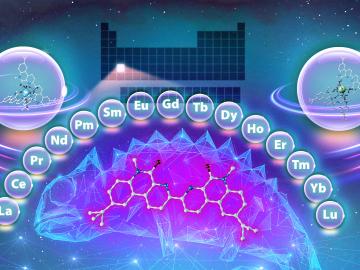
Filter News
Area of Research
- Advanced Manufacturing (2)
- Biology and Environment (23)
- Computational Engineering (1)
- Computer Science (1)
- Energy Frontier Research Centers (1)
- Energy Science (36)
- Fuel Cycle Science and Technology (1)
- Fusion and Fission (17)
- Fusion Energy (1)
- Isotope Development and Production (1)
- Isotopes (6)
- Materials (50)
- Materials for Computing (6)
- National Security (15)
- Neutron Science (14)
- Nuclear Science and Technology (11)
- Supercomputing (24)
News Type
News Topics
- (-) Artificial Intelligence (44)
- (-) Biomedical (30)
- (-) Chemical Sciences (44)
- (-) Composites (15)
- (-) Grid (23)
- (-) Nanotechnology (35)
- (-) Nuclear Energy (44)
- (-) Space Exploration (3)
- 3-D Printing/Advanced Manufacturing (61)
- Advanced Reactors (14)
- Big Data (20)
- Bioenergy (48)
- Biology (53)
- Biotechnology (17)
- Buildings (25)
- Clean Water (9)
- Computer Science (77)
- Coronavirus (23)
- Critical Materials (13)
- Cybersecurity (23)
- Education (3)
- Element Discovery (1)
- Energy Storage (56)
- Environment (78)
- Exascale Computing (16)
- Fossil Energy (1)
- Frontier (19)
- Fusion (26)
- High-Performance Computing (43)
- Hydropower (2)
- Isotopes (33)
- ITER (3)
- Machine Learning (23)
- Materials (69)
- Materials Science (71)
- Mathematics (5)
- Mercury (6)
- Microelectronics (1)
- Microscopy (28)
- Molten Salt (3)
- National Security (35)
- Neutron Science (64)
- Partnerships (33)
- Physics (42)
- Polymers (18)
- Quantum Computing (14)
- Quantum Science (36)
- Security (19)
- Simulation (18)
- Statistics (1)
- Summit (24)
- Transportation (38)
Media Contacts

Phong Le is a computational hydrologist at ORNL who is putting his skills in hydrology, numerical modeling, machine learning and high-performance computing to work quantifying water-related risks for humans and the environment.

From during his early years at NASA to his current role a researcher and group leader, Peter Fuhr has pushed the boundaries of optical and sensor technology. Fuhr’s path is marked by wacky creativity that can’t confine itself to challenges in a single field. No idea is too far out to try out — and so many of them work that Fuhr has a host of inventions and start-ups under his belt.

A chemical reaction can convert two polluting greenhouse gases into valuable building blocks for cleaner fuels and feedstocks, but the high temperature required for the reaction also deactivates the catalyst. A team led by ORNL has found a way to thwart deactivation. The strategy may apply broadly to other catalysts.

The Department of Energy announced a $67 million investment in several AI projects from institutions in both government and academia as part of its AI for Science initiative. Six ORNL-led (or co-led) projects received funding.

The Advanced Plant Phenotyping Laboratory at ORNL utilizes robotics, multi-modal imaging, and AI to enhance understanding of plant genetics and interactions with microbes. It aims to connect genes to traits for advancements in bioenergy, agriculture, and climate resilience. Senior scientist Larry York highlights the lab's capabilities and the insights from a new digital underground imaging system to improve biomass feedstocks for bioenergy and carbon storage.

A study led by the Department of Energy’s Oak Ridge National Laboratory details how artificial intelligence researchers created an AI model to help identify new alloys used as shielding for housing fusion applications components in a nuclear reactor. The findings mark a major step towards improving nuclear fusion facilities.

A new technical collaboration program at the Department of Energy’s Oak Ridge National Laboratory will help businesses develop and launch electric grid innovations. Sponsored by the Transformer Resilience and Advanced Components program in DOE’s Office of Electricity, the initiative will provide companies with access to national laboratory resources, enabling them to capture market opportunities.
After retiring from Y-12, Scott Abston joined the Isotope Science and Engineering Directorate to support isotope production and work with his former manager. He now leads a team maintaining critical equipment for medical and space applications. Abston finds fulfillment in mentoring his team and is pleased with his decision to continue working.

Researchers at the Department of Energy’s Oak Ridge National Laboratory have found a chemical “chameleon” that could improve the process used to purify rare-earth metals used in clean energy, medical and national security applications.

A team led by scientists at ORNL identified and demonstrated a method to process a plant-based material called nanocellulose that reduced energy needs by a whopping 21%, using simulations on the lab’s supercomputers and follow-on analysis.


